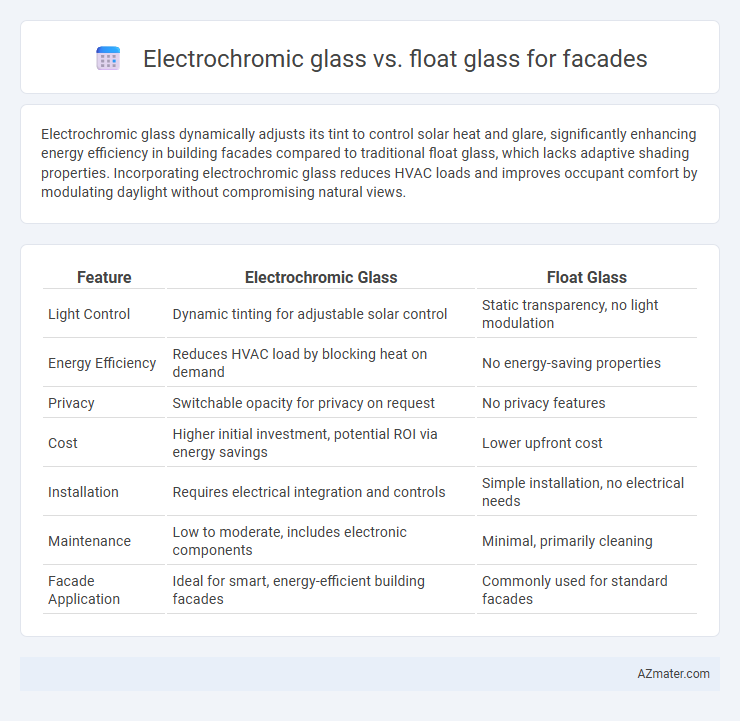Electrochromic glass dynamically adjusts its tint to control solar heat and glare, significantly enhancing energy efficiency in building facades compared to traditional float glass, which lacks adaptive shading properties. Incorporating electrochromic glass reduces HVAC loads and improves occupant comfort by modulating daylight without compromising natural views.
Table of Comparison
| Feature | Electrochromic Glass | Float Glass |
|---|---|---|
| Light Control | Dynamic tinting for adjustable solar control | Static transparency, no light modulation |
| Energy Efficiency | Reduces HVAC load by blocking heat on demand | No energy-saving properties |
| Privacy | Switchable opacity for privacy on request | No privacy features |
| Cost | Higher initial investment, potential ROI via energy savings | Lower upfront cost |
| Installation | Requires electrical integration and controls | Simple installation, no electrical needs |
| Maintenance | Low to moderate, includes electronic components | Minimal, primarily cleaning |
| Facade Application | Ideal for smart, energy-efficient building facades | Commonly used for standard facades |
Introduction to Electrochromic and Float Glass
Electrochromic glass features a dynamic tinting capability controlled by electrical voltage, enabling automatic regulation of light and heat transmission in building facades. Float glass, created through a continuous molten glass floating process, serves as the standard transparent material with stable optical properties for windows and facades. Compared to traditional float glass, electrochromic glass offers energy-efficient shading and glare control, enhancing facade performance in modern architectural designs.
How Electrochromic Glass Works
Electrochromic glass changes its tint by applying a low voltage that triggers a chemical reaction within multiple thin layers, allowing control over solar heat and light transmission. This dynamic modulation helps reduce glare and improve energy efficiency in building facades compared to static float glass, which lacks adaptive properties. The smart technology in electrochromic glass enhances occupant comfort and lowers HVAC loads by adjusting transparency based on environmental conditions.
What is Float Glass?
Float glass is a type of flat glass made by floating molten glass on a bed of molten metal, typically tin, forming a uniform thickness and smooth surface without distortion. It serves as the fundamental base material in architectural applications, including facades, due to its clarity, strength, and versatility. While electrochromic glass incorporates smart technology to dynamically control light and heat transmission, float glass provides the essential structural and optical properties that support such advanced functionalities.
Performance Comparison: Light and Heat Control
Electrochromic glass offers dynamic light and heat control by adjusting its tint in response to electrical signals, reducing solar heat gain and glare more effectively than float glass, which remains static and transmits maximum solar energy. This adaptive technology enhances energy efficiency and occupant comfort by modulating visible light transmittance and infrared radiation, unlike float glass that requires external shading devices for similar control. Consequently, electrochromic glass significantly lowers HVAC loads and improves natural daylight management, outperforming traditional float glass in modern facade applications.
Energy Efficiency: Electrochromic vs Float Glass
Electrochromic glass enhances energy efficiency by dynamically controlling solar heat gain and glare through adjustable tinting, reducing the need for artificial cooling and lighting in building facades. Float glass, while cost-effective and widely used, lacks adaptive properties and relies on fixed coatings or blinds to manage energy performance. Buildings utilizing electrochromic glass can achieve significant reductions in HVAC energy consumption and improve occupant comfort compared to those with traditional float glass facades.
Architectural Aesthetics and Design Flexibility
Electrochromic glass offers dynamic tinting capabilities, allowing architects to control light transmission and glare, enhancing facade aesthetics with adaptive shading and privacy without compromising views. Float glass, characterized by its uniform thickness and clarity, provides a cost-effective, neutral backdrop but lacks the ability to modulate transparency or color, limiting design versatility. The integration of electrochromic technology empowers innovative architectural expressions and responsive environments, surpassing the static nature of traditional float glass in design flexibility.
Cost Analysis: Initial Investment and Lifecycle
Electrochromic glass commands a higher initial investment compared to traditional float glass due to advanced manufacturing and embedded smart technology costs. Over its lifecycle, electrochromic glass can reduce energy expenses by dynamically controlling solar heat gain and glare, leading to lower HVAC loads and enhanced occupant comfort. Float glass requires additional treatments or coatings to approach similar performance, often resulting in higher maintenance and energy costs without the adaptive benefits of electrochromic systems.
Installation and Maintenance Considerations
Electrochromic glass requires specialized installation techniques to accommodate its electrical wiring and control systems, demanding trained professionals to ensure proper functionality and safety. Maintenance often involves periodic inspection of the electrical components and replacement of the control units to sustain performance, contrasting with float glass which involves simpler installation and minimal maintenance due to its static nature. The long-term operational cost of electrochromic glass can be higher due to the need for technical upkeep, whereas float glass offers a more cost-effective, low-maintenance solution for facades.
Sustainability and Environmental Impact
Electrochromic glass significantly reduces building energy consumption by dynamically controlling solar heat gain and natural light, leading to lower HVAC loads compared to traditional float glass. This smart glass technology supports sustainability goals by minimizing carbon footprints through decreased reliance on artificial cooling and heating systems. Unlike float glass, which lacks variable solar control, electrochromic glass enhances environmental performance by enabling adaptive facades that respond to changing climatic conditions.
Choosing the Right Glass for Your Facade
Electrochromic glass offers dynamic light and heat control by adjusting tint in response to electrical signals, enhancing energy efficiency and occupant comfort in facades. Float glass, while cost-effective and widely used, provides fixed transparency without adaptive solar control, making it less suitable for environments with variable sunlight exposure. Choosing the right glass depends on factors like climate, energy goals, and user comfort, where electrochromic glass excels in reducing glare and HVAC loads, whereas float glass suits simpler, budget-conscious projects.

Infographic: Electrochromic glass vs Float glass for Facade
 azmater.com
azmater.com